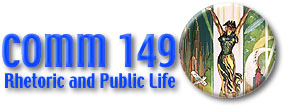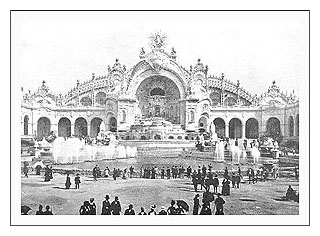
Office: HGH 210; phone: (408) 924-5378
Email: wooda@email.sjsu.edu
Web: http://www.sjsu.edu/faculty/wooda

|
Dr. Andrew Wood Office: HGH 210; phone: (408) 924-5378 Email: wooda@email.sjsu.edu Web: http://www.sjsu.edu/faculty/wooda |
Leo Marx describes the machine - epitomized by the locomotive which cuts a sharp path through the landscape - as the metaphor for industrialization in America. In a 1988 interview with Judith Lee, Marx wrote: "the general faith . . . was that things were going to get better and better - not only materially but also morally, politically, and socially - and this predominant view assumed that advancing technology was a sufficient basis for that progress" (p. 35). Departing from John Winthrop's notion that a community could build a new ideal public life in the image of God, many nineteenth century Americans began to imagine the machine in place of deity: "By the 1800s, the idea of progress was no longer dependent on divine guidance. It was attached instead to faith in reason, science, and technology - the works of man himself" (Garreau, 1991, pp. 365-366). Industrialized public life defined progress as a good unto itself.
In his autobiographical Education of Henry Adams, Adams (writing in third person) describes the almost spiritual power of progress, illustrated by a dynamo he discovers at the 1900 Paris Exposition:
 "To Adams the dynamo became a symbol of infinity. As he grew accustomed to the great gallery of machines, he began to feel the forty-foot dynamos as a moral force, much as the early Christians felt the Cross. The planet itself seemed less impressive, in its old-fashioned, deliberate, annual or daily revolution, than this huge wheel revolving within arm's reach at some vertiginous speeds, and barely murmuring - scarcely humming an audible warning to stand a hair's-breadth further for respond of power" (p. 380).
"To Adams the dynamo became a symbol of infinity. As he grew accustomed to the great gallery of machines, he began to feel the forty-foot dynamos as a moral force, much as the early Christians felt the Cross. The planet itself seemed less impressive, in its old-fashioned, deliberate, annual or daily revolution, than this huge wheel revolving within arm's reach at some vertiginous speeds, and barely murmuring - scarcely humming an audible warning to stand a hair's-breadth further for respond of power" (p. 380).
In his interview with Lee (1988), Marx contrasts this notion of progress of machine-power with the Jeffersonian-American ideal of pastoralism - illustrated by the garden metaphor: "there was a belief that we could resolve our deepest problems by building a simpler world combining the best of art and nature" (p. 36). Nineteenth and early twentieth century movements like Romanticism and the Arts and Crafts Movement, and - of course - the Garden City Movement and postwar suburbs illustrate the popular notion that the pastoral garden, rather than the machine-city, was essential to rediscover spiritualism in public life. Roger Aden (1999) writes that even the baseball field, with its green pasture and cyclical promise of a return home illustrates the pastoral ideal in public life. In his book, The Geography of Nowhere, James Kunstler (1993) makes plain the almost erotic power of the pastoral myth. Unlike the seventeenth century conflict over the simultaneous sin and beauty of the New World [Note], the uncultivated land in the nineteenth century contained the seeds of renewal in every sense.
To writers such as Marx and Garreau, the direction and shape of progress is not static. In film, poetry, architecture, and other artifacts of public life, we continue to debate whether progress is a benefit or harm to our souls:
In our efforts to confront the impact of the industrial revolution on public life, we continue to ask the same question: shall we go forward or back to the future? As we see in Christensen's discussion of Levittown, this debate illustrates a shift in American public life, from Utopia to Arcadia.
References
Notes
The role of the pastoral in America is full of contradiction. As Garreau recalls, Jamestown settlers looked upon "uncivilized" America and saw a paradise, even a new Eden. Thirteen years later, Pilgrims saw a "wilderness" whose demonic spirits must be tamed. Regardless of the outcome of that struggle, the American pastoral became the site where spiritual dimensions of public life were enacted and debated. [Return to Essay]
Off-campus webpages
Note: These pages exist outside of San Jose State University servers and their content is not endorsed by the page maintainer or any other university entity. These pages have been selected because they may provide some guidance or insight into the issues discussed in class. Because one can never step into the same electronic river twice, the pages may or may not be available when you request them. If you have any questions or suggestions, please email Dr. Andrew Wood.